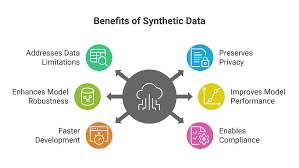Synthetic Data: Transforming AI Training and Model Development
- Get link
- X
- Other Apps
Synthetic Data: Transforming AI Training and Model Development
Introduction
In the fast-evolving world of artificial intelligence (AI), data is the backbone of model training and development. However, real-world data comes with challenges such as privacy concerns, data scarcity, and high acquisition costs. Enter synthetic data — a game-changer in AI training that offers scalable, high-quality, and privacy-compliant datasets for machine learning models.
In this article, we’ll explore the importance of synthetic data, how it enhances AI model development, and why it’s becoming a critical component in the future of AI.
What is Synthetic Data?
Synthetic data is artificially generated data that mimics real-world data but does not contain any personally identifiable information (PII). It is created using algorithms, statistical models, and simulations to replicate the patterns and characteristics of real datasets.
There are two main types of synthetic data:
- Fully Synthetic Data — Generated entirely using AI and statistical models.
- Partially Synthetic Data — A mix of real and synthetic data to maintain real-world attributes while ensuring privacy.
Why is Synthetic Data Essential for AI Training?
1. Privacy-Preserving Data Solutions
Many industries, such as healthcare and finance, deal with sensitive user data. Synthetic data eliminates privacy risks by providing anonymized datasets, allowing AI training without compromising user information.
2. Overcoming Data Scarcity
AI models require vast amounts of labeled data. However, collecting real-world data is expensive and time-consuming. Synthetic data provides an alternative by generating diverse and scalable datasets instantly.
3. Enhancing AI Model Performance
AI models trained on diverse datasets perform better in real-world applications. Synthetic data helps reduce bias and improve model accuracy by offering balanced datasets that cover edge cases and rare scenarios.
4. Cost-Effective Data Generation
Traditional data collection involves surveys, manual labeling, and real-world experiments — all of which are costly. Synthetic data reduces these costs by automating data generation at scale.
5. Simulation of Complex Scenarios
In fields like autonomous vehicles, robotics, and cybersecurity, real-world testing can be dangerous or impractical. Synthetic data enables safe and controlled environments to test AI models under extreme or rare conditions.
How Synthetic Data is Transforming AI Model Development
1. Healthcare and Medical Research
Synthetic patient data allows AI models to be trained on medical records without violating HIPAA or GDPR compliance regulations. This fosters breakthroughs in disease prediction, drug discovery, and personalized medicine.
2. Autonomous Vehicles
Self-driving cars rely on millions of driving scenarios for AI training. Synthetic data helps simulate road conditions, weather variations, and accident scenarios without real-world risks.
3. Financial Fraud Detection
Banks and fintech companies use synthetic data to train AI models for fraud detection without exposing real customer transactions, ensuring compliance with data protection laws.
4. Cybersecurity and Threat Detection
Cybersecurity firms generate synthetic attack scenarios to test and enhance AI-powered security systems against evolving cyber threats.
5. Natural Language Processing (NLP) and Chatbots
AI-powered chatbots and virtual assistants require large text datasets. Synthetic conversations and text data help NLP models learn efficiently without privacy concerns.
Challenges and Ethical Considerations of Synthetic Data
While synthetic data offers immense benefits, it also comes with challenges:
- Data Authenticity — Ensuring synthetic data accurately represents real-world patterns.
- Bias and Fairness — If the original dataset has bias, synthetic data can amplify it.
- Regulatory Compliance — Some industries still require synthetic data validation before use in AI models.
Future of Synthetic Data in AI
The demand for synthetic data is expected to grow exponentially as AI applications expand across industries. Advancements in generative AI, GANs (Generative Adversarial Networks), and deep learning will continue to refine synthetic data generation, making it more realistic and reliable for AI model training.
Organizations that adopt synthetic data early will gain a competitive edge by accelerating AI model development, reducing costs, and ensuring compliance with data privacy laws.
FAQs About Synthetic Data and AI Model Training
❓ 1. Is synthetic data as effective as real-world data?
Yes! When properly generated, synthetic data can replicate real-world patterns and improve AI model performance without privacy concerns.
❓ 2. How is synthetic data generated?
Synthetic data is created using AI algorithms, statistical models, and machine learning techniques such as GANs and variational autoencoders (VAEs).
❓ 3. Can synthetic data reduce AI bias?
Yes, synthetic data can help reduce bias by providing diverse and balanced datasets that ensure fair AI decision-making.
❓ 4. Is synthetic data legal to use?
Yes! Synthetic data is privacy-compliant and adheres to data protection laws like GDPR and HIPAA, making it legal for AI training.
❓ 5. What industries benefit most from synthetic data?
Industries like healthcare, finance, automotive, cybersecurity, and e-commerce benefit from synthetic data for AI model development.
Learn More About Data Science and AI Training
Interested in mastering data science and AI model training? Join our Data Science Online Training Program to gain hands-on experience in AI, machine learning, and data engineering.
Visit Now: Data Science Online Training
Start your journey into AI-driven innovation today!
- Get link
- X
- Other Apps



Comments
Post a Comment